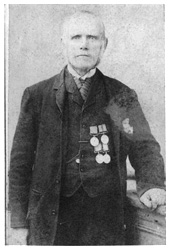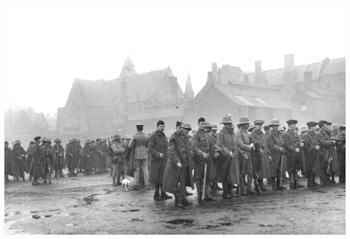The Munsters arrived at the harbour of Mudros, on the island of Lemnos, on the 10th of April. They looked with awe at the great armada of ships assembled there: French and Russian as well as British. Among the black ships there moved strangely rigged Greek boats, with peasant food for sale: meat and fish and wine.
They were at Mudros for two weeks — longer than expected because of unsettled weather, unsuitable for the planned landings. Time for more training and practice for what was expected to come.
Hamilton had done what he could, with what he had, to plan the landings, but what he had was little enough. Above all he lacked time. In the day or two available before leaving London, he had gathered a tourist book and a map. That map, somehow, symbolises the core problem of the entire campaign. It was drawn up sixty years before, for the Crimean War. The contours are few and far apart, no detail, deeply misleading. Now, for skilled map-readers, contours tell the story: contours far apart tell of a gentle terrain, easy for an army to stroll over, exactly opposite the reality of the jagged resistance offered by the actual landscape. In London, details of geography would not matter. Reality was different. The devil is in the detail.
Hamilton’s plan called for diversionary attacks on the Asian shore of the Dardenelles; for landings by the Anzacs in the north of the peninsula and for five landings: S, V, W, X, and Y around the southern tip.
On Friday, the 23rd of April, the weather cleared, and ship after ship, crammed with soldiers, began to move out of Mudros harbour. Geddes recorded that at 5.30 P.M. on that day the Munsters left for the great adventure. A perfect evening, he says, with solemnity and grandeur, cheering from the crews and bands playing.
But, he says:
What struck me most forcibly was the demeanour of our own men, from whom, not a sound, and this from the light hearted, devil-may-care men from the South of Ireland. Even they were filled with a sense of something impending which was quite beyond their ken.
Doubtless men were immersed in personal thoughts. One such was Lt. Col Doughty-Wylie. At home, two women, his wife and Gertrude Bell, his lover, had indicated that they might commit suicide if he were killed. He writes to Gertrude from the Clyde:
When I asked for this ship, my joy in it was half strangled by that you said, I can’t even name it or talk about it. As we go steaming in under the port guns in our rotten old collier, shall I think about it: Don’t do it. Time is nothing, we join up again, but to hurry the pace is unworthy of us all.
Now, the story of those landings has been told many times, not least by John Masefield, later to become poet laureate. But, it has to be said, that he was sent to report on the campaign with propagandist intent — and it shows. All is bathed in an effulgent, patriotic glow. Describing the departure of the ships, he writes of:
… the beauty and the exultation of the youth upon them like sacred things as they moved away ‘ All that they felt was a gladness of exultation that their young courage was to be used … Till all the life in the harbour was giving thanks that it could go to death rejoicing. All was beautiful in that gladness of men about to die, but the most moving thing was the greatness of their generous hearts.
The next day the Munsters were taken aboard the River Clyde. Geddes was lucky to be given hot chocolate and a shake down on his cabin floor by Commander Josiah Wedgwood, socialist M.P. and Navy Volunteer Reserve Officer. He had a pleasant night’s rest.
Beautiful dawn on the 25th, a slight haze but not a breath of wind. The day of the landings had arrived.
Now, some landings were to be much harder than others. None were picnics and, in particular, the exploits of the Lancashire Fusiliers, on W Beach, have been properly acclaimed. But there can be no doubt that those on board the River Clyde drew the short straw. Masefield described the landing on V beach as the worst and bloodiest of all the landings.
Commander Unwin’s plan for the assault was clever and ingenious, but would it work’ The River Clyde, an old collier, was his Trojan Horse. Armoured cars, in sandbagged emplacements, were strapped on deck to provide gun cover. Ports had been cut in her sides from which the men would emerge and gangways built out for them to run down. The Clyde was to be beached as near to the shore as possible and a string of lighter, barge-like vessels, which she towed, would form a bridge to the shore.
At the same time, other vessels, with most of 1st Dublins aboard would be towed fairly close inshore and row the rest of the way.
On board the Clyde were the four companies of Munsters, two of 1st Hampshires and one of 1st Dublins. About 2100 men.
So far, so neat.
V Beach was a narrow crescent, about 300 yards across, a natural amphitheatre: on the left, steep cliffs about fifty feet high, say twice the height of an average house; on the right, an old Fort; beyond that, the village of Sedd-el Bahr. Little cover for those landing; natural defences for the Turks. And Liman Von Sanders and the Turks had used their time effectively. Well-concealed trenches and formidable barbed wire — under the water as well as on the beach.
At 0500 the naval bombardment began. Churchill had used the power of the naval guns as an argument in pressing the merits of the campaign. He was wrong. The low trajectory of naval guns, compared to the dropping arc of land artillery, was less effective. The Turks were well spread out and little disturbed. They were disciplined, held their fire, and waited. They were not numerous; they did not need to be. Four machine guns, well placed, and a few score rifles, would be ample.
At 6.25 the River Clyde beached, with no jar. As she did so, the boats of the Dubliners came in alongside. They were met with a violent fury of rifle and machine gun fire. Geddes and Tizard saw the carnage with horrified apprehension. Slaughtered like rats in a trap, said Geddes. Many were killed or wounded in the boats; some were knocked into the water and tried to get a little protection by clinging to the sides of the boats; some tried to make it, up to their necks in the water; many drowned; some came back to rescue a mate, only to lose their own lives. A Navy flier saw the water, red with blood, for fifty yards from shore.
A few made it to the shore and found protection behind a small bank of sand.
Then the turn of the Munsters. X company, under Captain Geddes, on the port side; Z company, under Captain Henderson, on the starboard; Y company under Major Jarrett in support; W company, under Major Hutchinson, in reserve, on the River Clyde.
But first there were problems to be cleared up. The steam hopper towing the bridge of barges broke away, or got shot away, and the barges finished crossways in front of the Clyde. They were pulled back into place, under murderous fire, by Unwin and naval crew-members, with help from Fusiliers.
So Tizard now gave the order to disembark. Now, said Geddes: “we got it like anything, man after man behind me was shot down, but they never wavered.”
Knowing the exact point where the men were going to emerge, the Turks had a fixed and easy target. Someone counted the first 48 men to follow Geddes: all fell. Lieut. O’Sullivan, the bridegroom of January, fell. His best man, Lieut. Watts, wounded in five places, cheered the men on with cries of “follow the Captain”.
The barges gave trouble again, drifting in the strong current. Geddes, finding himself alone, had to jump into the sea and swim ashore. Many others who tried this drowned because of the great weight they were carrying: 84 lbs; full pack, 250 rounds of ammunition; 3 days rations.
Henderson’s company on the starboard side fared no better; Henderson himself was badly hit. He died from his wounds later.
The lighters became piled with dead and wounded; those following had to run over heaped bodies. Few, very few, made it to the shore and the protection of that little bank of sand. The landing was repulsed and the Turkish fire ceased at about 0800. There was, for a while, silence.
With a Sergeant and six men, Geddes tried to secure the right of the beach and get some sort of lodgement in the Fort but three were killed and he, himself, wounded
At about 0900, Tizard tried again, sending Major Jarrett and some of Y company. There was a spit of rock, which looked like a good spot to head for, but the enemy had got its range nicely, and it was a death trap. Few made it to the sheltering sandbank.
Hunter-Weston, divisional commander, had concentrated all his attention on W beach, to the complete exclusion of all other landings. Opposition there had been overcome. Hamilton, from his vantage point at sea, was aware of the problems on V beach and could see the advantage of diverting troops to W Beach. With his usual diffidence and unwillingness to interfere, he made this a question to Hunter-Weston, rather than an order, and it was ignored.
Later, Tizard, on the Clyde, spotted men from the next beach on the cliffs to his left. He sent a message to Divisional HQ, asking that they be used to outflank the Turkish defences. His message was ignored. Later came an order to continue with the landings, so Tizard unwillingly sent another company of Hampshires. Again the barge closest to the shore had become detached, so the Hampshires were halted. General Napier and his brigade major went to investigate and both were killed by shellfire. Nightingale watched Napier die.
Guy Nightingale was sent to join Jarrett’s company. He managed to get through the sea despite the bullets. Jarrett sent him back to the Clyde to advise Tizard not to send more men in daylight. Tizard took this advice, despite Hunter-Weston’s order.
Nightingale went back to the beach. Jarrett and he organised the few unwounded to set up some sort of defence. Jarrett was killed; Geddes was, by now, suffering too badly from wounds to do much. So the day passed, somehow, with cries of wounded under the searing sun.
At about 1700, it grew dark. The remainder of the troops on the Clyde could now get ashore safely. Geddes was evacuated to the Clyde and taken aboard a hospital boat next morning.
Tizard said that before the landing it had been surmised “that by 8 a.m. the ground above the beaches would have been won; by noon we should be in the vicinity of the village of Krithia, and have taken the Hill of Achi Baba that night.” These objectives were never reached in the eight months of the Gallipoli campaign.
Night would bring no rest for the survivors. At midnight, Hunter-Weston ordered that the advance should be continued.
 A few years back, when we took Clara for a new pair of specs, she persuaded me to get my eyes tested. She was tired of watching me squint at the small print, and, in the unselfconcious way of small children, suggested the obvious remedy. Duncan, a wise and experienced South African optician, put me through my paces. “You’ve always been a bit long-sighted” was his verdict “and as you get older that only gets worse. However I don’t think you need any help yet. Come back and see me when you’re 41 and a half. You’ll be needing glasses then.”
A few years back, when we took Clara for a new pair of specs, she persuaded me to get my eyes tested. She was tired of watching me squint at the small print, and, in the unselfconcious way of small children, suggested the obvious remedy. Duncan, a wise and experienced South African optician, put me through my paces. “You’ve always been a bit long-sighted” was his verdict “and as you get older that only gets worse. However I don’t think you need any help yet. Come back and see me when you’re 41 and a half. You’ll be needing glasses then.”



